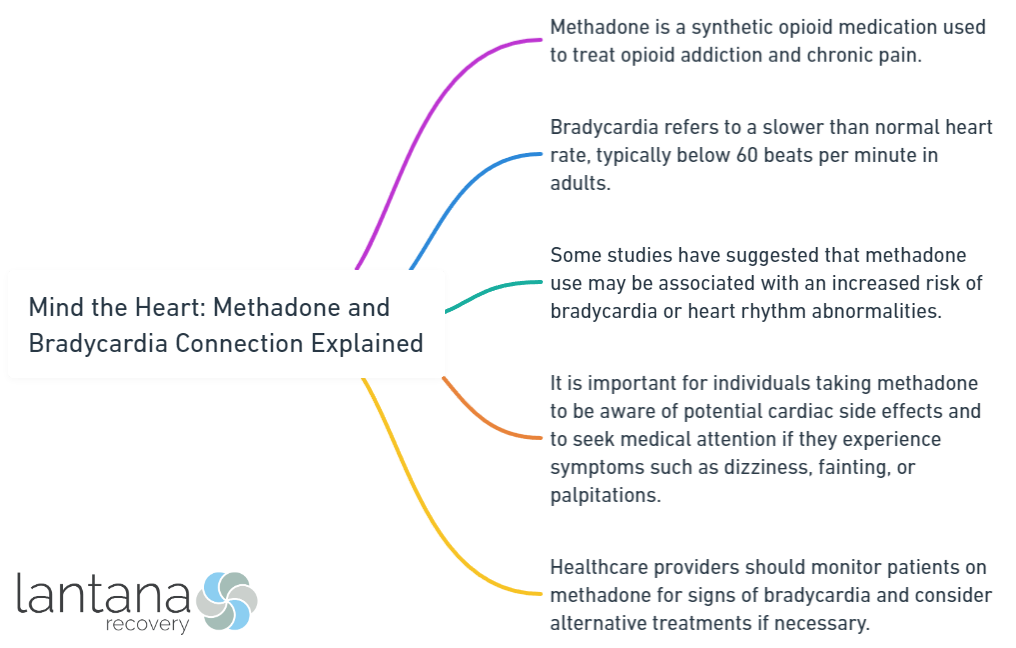Methadone, a medication primarily used for managing opioid addiction, has been associated with a potential side effect called bradycardia. Understanding the connection between methadone and bradycardia is crucial for healthcare professionals and patients alike. In this article, we will delve into the details of this correlation, shedding light on the causes, symptoms, diagnosis, and treatment of methadone-induced bradycardia.
It is important to note that methadone use can lead to cardiovascular adverse events, including bradycardia.
Before exploring the connection, let’s first understand methadone itself. Methadone is a synthetic opioid that is commonly prescribed as a maintenance treatment for individuals with opioid dependence. It helps reduce withdrawal symptoms, cravings, and the risk of relapse in individuals undergoing opioid addiction treatment.
Bradycardia, on the other hand, refers to an abnormally slow heart rate, typically lower than 60 beats per minute. It can occur due to various factors, including certain medications, underlying heart conditions, or disruptions in the electrical signaling of the heart.
The connection between methadone and bradycardia arises from the effects of methadone on the cardiovascular system. Methadone has the potential to suppress the electrical activity of the heart, leading to a slower heart rate. This can manifest as symptoms such as dizziness, fatigue, fainting, and even serious complications if left untreated.
Certain risk factors may increase the likelihood of methadone-induced bradycardia, including higher methadone doses, concomitant use of other medications that affect heart rhythm, and underlying heart conditions.
Diagnosing methadone-induced bradycardia involves evaluating the patient’s symptoms, conducting an electrocardiogram (ECG), and ruling out other potential causes of bradycardia.
Treatment options for methadone-induced bradycardia focus on managing the underlying cause and optimizing heart rate. This may involve adjusting the methadone dosage, discontinuing certain medications, or considering alternative treatment options for opioid addiction.
It is crucial for healthcare providers to closely monitor the cardiovascular health of individuals on methadone and educate them about the signs and symptoms of bradycardia. Prompt recognition and management of this side effect are essential to ensure the overall well-being and safety of patients undergoing methadone treatment.
By understanding the methadone and bradycardia connection, healthcare professionals, patients, and their families can work together to mitigate the risks and optimize treatment outcomes for individuals on methadone therapy.
What Is Methadone?
Methadone is a synthetic opioid used to treat opioid addiction and chronic pain. It acts on the same brain receptors as heroin or oxycodone but in a slower and less intense way. Methadone reduces withdrawal symptoms, cravings, and the euphoric effects of other opioids. Unlike short-acting opioids, methadone stays in the body longer due to its long half-life. This allows for once-daily dosing, making it convenient for those in addiction treatment programs.
Methadone is also used for the treatment of severe chronic pain.
It’s important to take methadone under the supervision of a healthcare professional at an institution like Lantana Recovery to avoid misuse and overdose. The dosage is carefully monitored and adjusted according to individual needs. When considering methadone, it’s crucial to weigh the benefits and potential risks. It can effectively reduce cravings and improve overall quality of life, but may also cause drowsiness, constipation, and respiratory depression.
If you or someone you know is considering methadone treatment, consult with a healthcare professional to determine its suitability for individual needs and circumstances.
Why Is Methadone Prescribed?
It is important to understand why Methadone is prescribed. Methadone helps individuals overcome addiction to opioids by binding to the same receptors in the brain, which reduces withdrawal symptoms and cravings. Additionally, Methadone provides long-lasting pain relief for people with chronic pain that is not controlled by other medications. As a chronic opioid therapy, it is crucial to consider the potential increased risk of cardiovascular adverse events, such as hypotension, bradycardia, ischemic events, heart failure, arrhythmias, myocardial infarction, and coronary revascularization.
It can be used for individuals who have developed a tolerance to other opioids and need higher doses for pain relief. Qualified healthcare professionals should prescribe Methadone, taking into account the individual’s medical history, current medications, and overall health. Regular monitoring and follow-up visits are necessary for safe and effective treatment.
How Does Methadone Work?
Methadone is a medication used to treat opioid addiction and chronic pain. It works by binding to opioid receptors in the brain, which helps to block the euphoric effects of opioids and reduce withdrawal symptoms.
Methadone is a synthetic opioid, different from natural opioids such as morphine and codeine, which are derived from opium. When taken orally, methadone travels to the brain and occupies opioid receptors, preventing other opioids from attaching and restoring normal brain function.
One of the benefits of methadone is its long-acting nature, providing sustained relief throughout the day. However, it is important to remember that methadone should only be taken under the supervision of a healthcare professional, as part of a comprehensive treatment program.
Regular monitoring is necessary to ensure the appropriate dosage is maintained and to manage any potential side effects or complications that may arise.
What Is Bradycardia?
Bradycardia is a condition characterized by a slow heart rate. The heart beats at a rate lower than the normal range of 60 to 100 beats per minute. Bradycardia can be caused by underlying health conditions, certain medications, or aging. Underlying cardiac disease can also be a cause of bradycardia.
Symptoms of bradycardia vary depending on its severity. Some individuals may not have any symptoms, while others may experience dizziness, fatigue, shortness of breath, or fainting. If left untreated, bradycardia can increase the risk of complications like heart failure or cardiac arrest.
Doctors use an electrocardiogram (ECG) to diagnose bradycardia and identify any abnormalities in the heart’s electrical activity. Treatment depends on the underlying cause and symptom severity. In some cases, no treatment is needed if the slow heart rate doesn’t cause any issues. However, if symptoms are severe or complications are likely, treatment options include medication, pacemaker implantation, or lifestyle changes.
If you suspect you have bradycardia or experience symptoms of a slow heart rate, consult a healthcare professional. Early detection and proper management can prevent complications and ensure heart health.
What Are the Causes of Bradycardia?
Bradycardia, a slow heart rate, can be caused by various factors. Understanding these causes is crucial in identifying and managing the condition effectively.
1. Age-related changes: Our heart muscles weaken as we age, leading to a slower heart rate. Older individuals are more prone to developing bradycardia.
2. Medications: Certain medications, such as beta-blockers for high blood pressure or heart disease, can lower heart rate and potentially cause bradycardia.
3. Heart conditions: Coronary artery disease, heart attack, heart failure, and congenital heart defects can disrupt the heart’s electrical system and result in bradycardia.
4. Hypothyroidism: An underactive thyroid gland can cause a decrease in metabolism, including a slower heart rate.
5. Infections: In rare cases, infections like endocarditis can lead to bradycardia.
6. Sleep apnea: This sleep disorder, characterized by interrupted breathing during sleep, can affect heart rate and rhythm, potentially causing bradycardia.
7. Electrolyte imbalances: Abnormal levels of electrolytes like potassium or calcium in the blood can interfere with the heart’s electrical impulses, resulting in bradycardia.
8. Some athletes or individuals with high levels of cardiovascular fitness may develop bradycardia due to a strong and efficient heart.
It is important to note that bradycardia can have serious implications and should be evaluated and treated by a medical professional. Symptoms such as fatigue, dizziness, fainting, or chest pain should prompt immediate medical attention.
True story: Jane, a 60-year-old woman, noticed a decrease in her energy levels and frequent dizziness. Her bradycardia was caused by age-related weakening of the heart muscles. With proper medical treatment, including medication adjustments and lifestyle modifications, Jane’s heart rate improved, and she regained her vitality. This case emphasizes the importance of understanding the causes of bradycardia and seeking appropriate medical assistance for diagnosis and management.

The Connection Between Methadone and Bradycardia
The connection between methadone and bradycardia is crucial for individuals undergoing methadone treatment. Methadone, a commonly prescribed medication for opioid addiction, works by binding to brain receptors like other opioids, reducing withdrawal symptoms and cravings. However, one potential side effect of methadone is bradycardia, which refers to a slow heart rate. Methadone can also cause drug-induced QT prolongation, which can lead to bradycardia.
Bradycardia occurs because methadone impacts the electrical signals that regulate the heart rate. This can lead to symptoms such as dizziness, fatigue, and fainting. Although the risk of developing bradycardia while taking methadone is relatively low, healthcare providers should regularly monitor patients’ heart rates, particularly during initial treatment or adjustments to the dosage. In severe cases, medical intervention may be necessary.
Healthcare providers may employ the following strategies to manage the connection between methadone and bradycardia:
1. Regular cardiovascular monitoring: It is important for healthcare providers to consistently monitor the heart rates of patients and make necessary dosage adjustments.
2. Medication adjustments: In some instances, adjusting the dose of diazepam, methadone or considering alternative medications may be required to minimize the risk of bradycardia.
3. Lifestyle modifications: Patients should avoid activities that could exacerbate bradycardia, such as excessive use of other heart rate-lowering medications or engaging in strenuous exercise.
Individuals undergoing methadone treatment should inform their healthcare provider about any symptoms or concerns regarding their heart rate. By closely monitoring and managing the connection between methadone and bradycardia, healthcare professionals can ensure the safe and effective use of this medication for treating opioid addiction.
How Does Methadone Contribute to Bradycardia?
Methadone contributes to bradycardia, a slowed heart rate. It affects the central nervous system by inhibiting certain neurotransmitters released in the brain, including norepinephrine, which regulates heart rate.
This reduction in norepinephrine levels leads to a decrease in heart rate and contributes to bradycardia. Methadone also causes QTc interval prolongation on electrocardiograms, which disrupts the electrical activity of the heart and can result in bradycardia.
However, not everyone who takes methadone will experience bradycardia. Factors such as dosage, duration of use, and individual susceptibility can influence the likelihood of this side effect. Regular monitoring of heart rate and electrocardiograms is necessary for methadone patients to detect and manage bradycardia.
What Are the Risk Factors for Methadone-Induced Bradycardia in Patients with Underlying Cardiac Disease?
“Methadone use, despite being a well-known cause of prolonged QTc interval and torsades de pointes (TdP), continues to be prescribed indiscriminately” (Drug-induced torsades de pointes in an underserved urban population. Methadone: is there therapeutic equipoise?, Romero et al., 2015.) Risk factors for methadone-induced bradycardia can vary. Several factors can increase the likelihood of bradycardia when taking methadone. It is important to be aware of these risk factors for proper monitoring and management of heart health.
1. Dosage: Higher doses of methadone may increase the risk of bradycardia. Follow the prescribed dosage and consult with a healthcare professional to determine the appropriate dose for your condition.
2. Age: Older individuals may be more susceptible to methadone-induced bradycardia. Age-related changes in heart function and metabolism can affect methadone processing, potentially leading to bradycardia.
3. Pre-existing heart conditions: People with heart disease or cardiac arrhythmias may have a higher risk of developing bradycardia while using methadone. Close monitoring by a healthcare professional is essential.
4. Concomitant use of other medications: Certain medications, when used with methadone, can increase the risk of bradycardia. Inform your healthcare provider about all medications you are taking.
5. Genetic factors: Genetic variations can affect how methadone is metabolized. Some individuals may be more prone to developing bradycardia due to these genetic factors.
Remember, while these risk factors may increase the likelihood of methadone-induced bradycardia, it does not mean everyone with these risk factors will develop bradycardia. Regular monitoring and open communication with your healthcare provider are essential for a safe and effective treatment plan.
Pro-tip: If you experience symptoms like dizziness, fainting, or an irregular heartbeat while taking methadone, seek immediate medical attention. Prompt diagnosis and appropriate management can help prevent complications.

Symptoms and Diagnosis of Methadone-Induced Bradycardia
Symptoms and diagnosis of methadone-induced bradycardia can vary. It’s crucial to recognize these symptoms and seek medical attention for a diagnosis and treatment. Severe cases of methadone-induced bradycardia can lead to complications such as acute respiratory distress syndrome.
- Slow heart rate: Methadone-induced bradycardia is characterized by a slower-than-normal heart rate. Symptoms may include fatigue, shortness of breath, dizziness, and fainting.
- Irregular heartbeat: Methadone-induced bradycardia can cause an irregular heartbeat, also known as arrhythmia. This can lead to palpitations, chest pain, and discomfort.
- Decreased exercise tolerance: Individuals experiencing methadone-induced bradycardia may notice a decrease in their ability to engage in physical activity. They may feel easily fatigued or find it challenging to exercise.
- EKG abnormalities: Electrocardiogram (EKG) is a diagnostic tool used to identify and monitor heart rhythm abnormalities. It can help detect bradycardia and determine its severity.
- Medical evaluation: If you experience these symptoms, consult a healthcare professional for a thorough evaluation. The healthcare provider will review your medical history, perform a physical examination, and order diagnostic tests, including an EKG, to confirm the diagnosis.
Early recognition and diagnosis of symptoms related to methadone-induced bradycardia are crucial. Seeking prompt medical attention can help prevent complications and maintain optimal heart health.
What Are the Signs and Symptoms of Bradycardia?
Bradycardia is a condition characterized by a slow heart rate. It is important to know the signs and symptoms of bradycardia for early detection and proper treatment. Signs and symptoms of bradycardia may vary depending on severity and individual factors. Here are the common indications to look out for:
1. Fatigue and weakness: Patients with bradycardia often experience persistent tiredness and lack of energy.
2. Dizziness and lightheadedness: A slow heart rate can reduce blood flow to the brain, causing dizziness and lightheadedness.
3. Fainting or near-fainting: Severe cases of bradycardia can result in temporary loss of consciousness due to inadequate blood flow to the brain.
4. Shortness of breath: Insufficient blood circulation affects oxygen supply, leading to difficulty in breathing.
5. Chest pain or discomfort: Some individuals with bradycardia may experience chest pain, though this symptom is less common.
If any of these signs and symptoms are noticed, it is crucial to consult a healthcare professional for proper diagnosis and treatment. Tests such as an electrocardiogram (ECG) may be conducted to evaluate the heart’s electrical activity and identify the cause of bradycardia. Remember, bradycardia can occur due to factors like medication use, underlying heart conditions, and aging. Prompt medical attention can help determine the cause and guide appropriate management for each individual.
How Is Methadone-Induced Bradycardia Diagnosed?
Methadone-induced bradycardia is diagnosed through a comprehensive medical examination. Healthcare professionals evaluate symptoms, medical history, and medication usage, including methadone. An electrocardiogram (ECG) is then used to measure the heart’s electrical activity and detect abnormalities in rhythm caused by bradycardia. Serial ECGs may be conducted over time to monitor the condition. Other tests, such as an echocardiogram, stress tests, or Holter monitoring, may be employed to gather more information and rule out other causes of bradycardia. It is important for individuals taking methadone to promptly inform their healthcare provider like experts at Lantana Recovery, Greenville, SC of any symptoms like dizziness, fatigue, or fainting. Regular monitoring of heart health is crucial for their well-being.

Treatment and Management of Methadone-Induced Bradycardia
Treatment and management of methadone-induced bradycardia is crucial for patient well-being. Several important considerations exist for addressing this condition effectively. Intravenous methadone administered can also lead to bradycardia and requires careful monitoring.
- Close monitoring: Patients on methadone should have regular electrocardiograms (ECGs) to detect abnormal heart rhythms, including bradycardia (slow heart rate).
- Medical intervention: If methadone-induced bradycardia is diagnosed, healthcare providers may adjust the dosage or switch to an alternative medication based on severity and individual circumstances.
- Consulting a cardiologist: Some cases may require referral to a cardiologist for further evaluation and specialized treatment.
- Lifestyle modifications: Lifestyle changes like quitting smoking, limiting alcohol consumption, and following a balanced diet, along with regular exercise, can improve cardiovascular function.
- Educating patients: Comprehensive information about bradycardia signs, symptoms, and adherence to the treatment plan is essential. Patients should be aware of potential complications for timely medical attention.
True Story: A 45-year-old man, John, undergoing methadone maintenance treatment for opioid addiction, experienced symptoms of fatigue, dizziness, and fainting spells. John immediately reached out to his healthcare provider. After examination, he was diagnosed with methadone-induced bradycardia.
John’s healthcare provider adjusted his medication dosage promptly and referred him to a cardiologist specializing in managing opioid-related cardiac complications. With the combined efforts of his healthcare team, John’s bradycardia was successfully managed, and his symptoms improved. He received education on regular ECG monitoring and making appropriate lifestyle changes to support heart health.
This true story highlights the importance of prompt detection, intervention, and patient education in the treatment and management of methadone-induced bradycardia.
How Is Methadone-Induced Bradycardia Treated?
Methadone-induced bradycardia is treated based on the severity of the condition and the individual patient’s needs. Treatment options for Methadone-Induced Bradycardia may include medications such as atropine or isoproterenol to increase heart rate. Additionally, adjusting the dosage of methadone or discontinuing it altogether if it causes bradycardia may be necessary.
In more severe cases, pacemaker implantation may be required. Regular heart monitoring is essential to evaluate the effectiveness of the treatment. Patients should promptly inform their healthcare provider about any changes in heart rate or symptoms. With effective treatment and vigilant monitoring, it is possible to manage Methadone-Induced Bradycardia while ensuring optimal heart health.
Are there any Precautions or Guidelines for Patients Taking Methadone?
When it comes to taking methadone, there are important precautions and guidelines that patients need to follow in order to ensure their safety and maximize the effectiveness of the medication. It is crucial to take methadone exactly as prescribed, without taking more or less than instructed. Additionally, it is essential to avoid consuming alcohol while on methadone, as this can not only amplify the side effects but also pose a potential danger.
In addition, it is imperative to inform your healthcare provider about any other medications or substances you may be taking, including over-the-counter medications, herbal supplements, methamphetamine to lose weight, and illicit drugs. Methadone has the potential to interact with certain medications, which can result in harmful effects. Therefore, it is crucial to keep your healthcare provider well-informed.
If you happen to experience any concerning side effects such as difficulty breathing, chest pain, or severe drowsiness, it is imperative to seek immediate medical attention. These symptoms should not be ignored and require prompt evaluation and treatment.
Furthermore, it is crucial to regularly attend follow-up appointments with your healthcare provider in order to monitor your progress, discuss any concerns you may have, and make any necessary adjustments to your treatment plan. These appointments are important for ensuring the safety and effectiveness of your methadone treatment.
By adhering to these precautions and guidelines, patients taking methadone can ensure their safety and overall well-being throughout the course of their treatment. It is important to remember that methadone maintenance treatment has been proven to not only reduce opioid use but also decrease the risk of overdose and improve the overall quality of life for individuals struggling with opioid addiction.
Frequently Asked Question
How does methadone impact heart health?
Methadone, a synthetic opioid used for pain management and opioid addiction treatment, can have cardiotoxic effects. It can cause QT interval prolongation and torsade de pointes (TDP), a life-threatening arrhythmia.
Acute opioid withdrawal can also have significant cardiovascular effects, including bradycardia.
What is the significance of QTc interval prolongation and TDP?
QT interval prolongation and TDP are abnormal cardiac repolarization processes that can be caused by methadone use. TDP can occur in patients with profoundly prolonged QT intervals (≥ 500 msec), leading to a life-threatening irregular heart rhythm.
What are the recommended doses of methadone for pain relief and opioid addiction treatment?
The recommended dose of methadone for pain relief is 2.5-10 mg every 3-4 hours, while for methadone maintenance treatment in opioid addiction, doses range from 30 to 120 mg/day.
Can methadone interact with other medications and affect heart function?
Yes, methadone can interact with certain medications, including those that prolong the QT interval. These interactions can further increase the risk of heart rhythm abnormalities and potential cardiotoxicity.
How can healthcare professionals prevent heart toxicity in methadone users?
Healthcare professionals should monitor the QT interval in methadone users and consider potential drug interactions that may prolong the QT interval. Monitoring and awareness can help prevent or manage potential cardiac side effects.
What is the overall importance of monitoring heart health in patients taking methadone?
Monitoring heart health is crucial in patients taking methadone due to its potential cardiotoxicity. Regular monitoring of cardiac repolarization and QT interval can ensure early detection and management of any abnormalities, reducing the risk of life-threatening arrhythmias.










